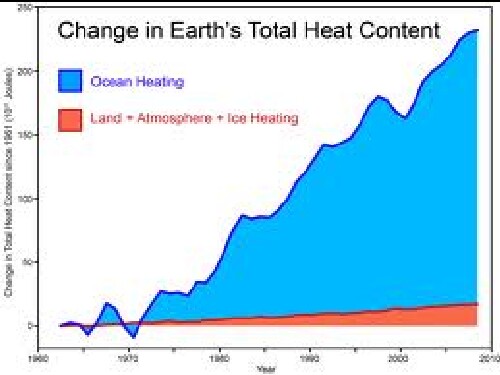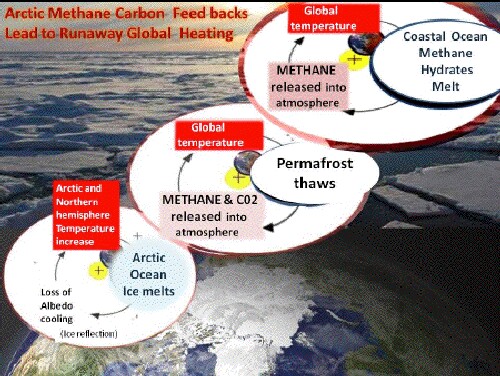L. David Roper, http://www.roperld.com/personal/roperldavid.htm
04-Apr-2016
Feedbacks
Positive feedback: An effect that increases global warming
- Warming decreases the amount of snow and ice on Earth's surface. Since snow and ice reflect much more sunlight than does land or water, this increases global warming. Of course, the increased warming causes more snow and ice to melt; a mutual positive feedback situation.
- The liquid water that warming converts to vapor into the atmosphere greatly increases global warming. This is a mutual positive feedback situation.
- Wildfires are increased by global warming drying out areas that are generally dry anyway. Those fires emit much carbon and heat into the atmosphere, which greatly increases atmospheric warming. The peat under boreal forests also burns when the forest burns, thereby releasing much more carbon into the atmosphere. This is a mutual positive feedback situation.
- A huge amount of methane is trapped within crystal structures of water molecules (methane clathrate) in polar-region soil and on outer continental shelves. Warming can change the temperature and pressure conditions required for clathrate formation and thereby release large amounts of methane into the atmosphere; some of the released methane migrates to the atmosphere. Methane is a very powerful global-warming gas. In an average of 12 years it converts to carbon dioxide and water, both potent global-warming gases. This is a mutual positive feedback situation.
- Because water has a much higher thermal capacity and thermal conductivity than air, most of the warming occurs in the oceans than in the atmosphere.
 . If we quit putting carbon into the atmosphere, the atmosphere would continue to get warmer because the huge amount of heat in the oceans will conduct into the atmosphere. So, there is a long term ocean to atmosphere feedback. Also, much of the carbon dioxide emitted by burning fossil fuels is dissolved into the oceans making it more acidic than normal, which greatly disrupts the ecology of the oceans.
. If we quit putting carbon into the atmosphere, the atmosphere would continue to get warmer because the huge amount of heat in the oceans will conduct into the atmosphere. So, there is a long term ocean to atmosphere feedback. Also, much of the carbon dioxide emitted by burning fossil fuels is dissolved into the oceans making it more acidic than normal, which greatly disrupts the ecology of the oceans.

http://www.zero-carbon-or-climate-catastrophe.org/runaway-heating.html
Negative feedback: An effect that decreases global warming
- If the increased water vapor forms low clouds those clouds reflect sunlight back into space, thus decreasing warming.
Triggers (Tipping Points) of Massive Global Warming
- If warming rapidly melts ice on Antarctica it could trigger a rapid collapse of the ice into the warmer ocean causing much more rapid warming after it melts, which leads to rapid rise in sea level.
- Release of methane from methane clathrates in polar regions and on continental shelves could occur very rapidly causing rapid global warming.
- People tipping point!! The underlying problem is too many people demanding too many goods and too much energy! We have already passed this tipping point.
Global Warming and Renewable Energy
To stop global warming we must quit burning fossil fuels for energy and switch to renewable energy. Unfortunately, the more warming that occurs makes it more difficult to switch to renewable energy. Here are some of the reasons:
- In dry areas where the sunlight is more available dust storms due to arid soil can reduce the sunlight and cover the solar collectors.
- In wet areas low clouds reduce the available sunlight and warming increases the cloud cover.
- The wind patterns that are so important in siting large wind turbines can drastically change as warming occurs.
We need to switch to renewable energy quickly before it gets more difficult to do so. Here is an interesting study that shows that renewable energy is less expensive than fossil-fuels energy in the European Union when all hidden costs are included:
- Wind: $0.133/kilowatt-hour
- Solar: $0.158/kilowatt-hour
- Nulear: $0.158/kilowatt-hour
- Natural Gas: $0.207/kilowatt-hour
- Coal: $0.294/kilowatt-hour
References
 . If we quit putting carbon into the atmosphere, the atmosphere would continue to get warmer because the huge amount of heat in the oceans will conduct into the atmosphere. So, there is a long term ocean to atmosphere feedback. Also, much of the carbon dioxide emitted by burning fossil fuels is dissolved into the oceans making it more acidic than normal, which greatly disrupts the ecology of the oceans.
. If we quit putting carbon into the atmosphere, the atmosphere would continue to get warmer because the huge amount of heat in the oceans will conduct into the atmosphere. So, there is a long term ocean to atmosphere feedback. Also, much of the carbon dioxide emitted by burning fossil fuels is dissolved into the oceans making it more acidic than normal, which greatly disrupts the ecology of the oceans. 
